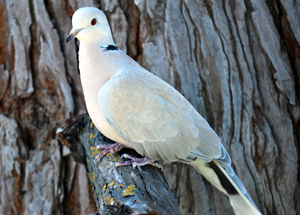
- VisitSupport Happy HollowDONATE TODAYExploreSupport Happy HollowDONATE TODAYLearnSupport Happy HollowDONATE TODAYSupport
-
Today's Hours: 10:00 am to 5:00 pm
Education AmbassadorsDomestic barbary dove

Scientific name: Streptopelia risoria
Family: Columbidae
Order: Columbiformes
Class: Aves
Range: Originally Western Africa, Domesticated worldwide
Habitat: Desert, Grassland, Urban
Lifespan: Up to 12 yearsWhat do they look like?
Barbary doves are a pale grayish-fawn with blue gray along the wing edge. There is a black ring extending halfway around the back of the neck. Their bill is grey and their feet are red. This species has been selectively bred in over 40 other colors and varieties, including white, tangerine, roan, rosy, pink, frosted, pied and silky.How do they behave?
The Barbary dove has been domesticated for over 2,000 years. They are descended from the African collared dove. Both male and female barbary doves make different sounds for various communications, including alarm calls and mating coos. Their flight is characterized by noisy wing beats when flying upwards and quiet downward gliding with outstretched tail and wings. Barbary doves maintain an instinctive freeze response when startled by a shadow overhead, as this may indicate a predator is nearby. They often bathe in shallow water, dust, or sunshine, sometimes lying on their side with a wing outstretched.What do they eat?
These doves feed on the ground and eat a range of different seeds, which are swallowed whole. They also peck at the soft shoots of low-growing plants. Barbary doves have a unique beak that helps them to not only suck up seeds, but also water. They use their beak the same way we would use a straw. At Happy Hollow, the Barbary doves eat specialized bird food composed of small seeds.How are they born?
Male doves perform elaborate bows to entice a female to breed. The pair constructs a haphazard nest of sticks, and the hen lays two white eggs. The pair will share incubation duties for two weeks. When the eggs hatch, the barbary dove chicks will be altricial (born not fully developed and reliant on their parents to take care of them). These chicks will grow quickly, reaching their adult size around six weeks. Both parents feed the young “crop milk,” the sloughed lining of their upper digestive pouch.What should you know about them?
These doves are widely used in research. Their quick and recognizable breeding cycle allows scientists to study the effect of hormones on behavior. For example, the pair of doves coordinates the decision to construct a nest and synchronize production of crop milk between each parent. The hormones which regulate these behaviors are comparable to other vertebrates, including humans.Conservation
Barbary doves have adapted to live in several different environments and their conservation status is listed as Least Concern by the International Union for Conservation of Nature . Sometimes doves, including barbary doves, are purchased from pet stores and released at special events. This can be harmful to both the doves and the local wildlife because the doves may not know how to survive on their own, and could end up taking valuable resources from native wildlife in the area. If you would like to help barbary doves, educate your friends about them and make sure not to release them at your special events.
Zoo on the Hill
Located across from the Keep-Around Carousel is the Zoo on the Hill. Learn about wildlife up close during daily meet-and-greets, leap like a lemur on the playground, brush and feed the goats,, or take a peek inside Doc’s Critter Care building and the Ranch House. Double-H Ranch features a combination of animal exhibits, including giant anteaters and red ruffed lemurs, as well chickens and domesticated animals that are docile enough to touch.
See Animals
Zoo in the Hollow
Follow the crooked bamboo pathway down into the hollow and visit with some of the most amazing animals in the world. Where else in San José can you get up close to a stunning jaguar, lemur, meerkat or American alligator? Happy Hollow is dedicated to helping save species and preserve wildlife for future generations by participating in Species Survival Plan programs through the Association of Zoos and Aquariums.
See AnimalsVisit Us Today
Plan an unforgettable experience at San Jose’s family-friendly park and zoo.
more info